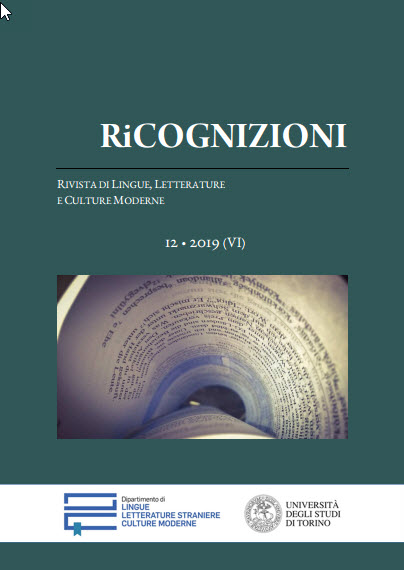IL LINGUAGGIO FIGURATO NELLA COMUNICAZIONE MULTIMODALE: IL GENERE PUBBLICITARIO E LA CAMPAGNA SOCIALE
DOI:
https://doi.org/10.13135/2384-8987/3510Keywords:
verbopictorial metaphor, advertising, visual communication, visual metonymy.Abstract
This paper outlines and discusses the main findings and the main open issues related to the analysis of figurative language (in particular, metaphor and metonymy) used within the genre of advertising and social campaigns. The issues hereby addressed include: the interaction of linguistic and pictorial elements within these polisemiotic texts and their role in constructing metaphors; the problems related to theoretical models that tackle a single level of analysis, neglecting the ability of these images to evoke multiple layers of abstraction; the role played by metonymy in crossing such layers; the perceived complexity within these constructions; and finally, the identification of a specific type of metaphors, in which different senses are crossed, stimulating the viewer to construct a synesthetic metaphor. Within this complex scenario, it is hereby argued that a cross-disciplinary approach, informed by semiotic as well as by cognitive theories, is arguably more successful in explaining exhaustively the structure and functioning of metaphor in these images.
References
Cornevin, V., Forceville, C. (2017), From metaphor to allegory The Japanese manga Afuganisutan, Metaphor and the Social World, 7, 2, 235–251.
Domínguez, M. (2015), The metaphorical species: evolution, adaptation and speciation of metaphors. Discourse Studies 17, 4, 433-448.
El Refaie, E. (2003), Understanding visual metaphor: the example of newspaper cartoons, Visual Communication, 2, 2, 75-95.
Forceville, C. (1996), Pictorial Metaphor in Advertising, London, Routledge.
Geeraerts, D., & Peirsman, Y. (2011). Zones, facets and prototype-based metonymy. In R. Benczes, A. Barcelona, F. Ruiz de Mendoza Ibañez (eds.), What is metonymy? An attempt at building a consensus view on the delimitation of the notion of metonymy in Cognitive Linguistics, Amsterdam, John Benjamins, 98-102.
Jakobson, R., Halle, M. (1956), Fundamentals of language, 'S-Gravenhage, De Gruyter Mouton.
Kress, G., Van Leeuwen, T. (2006), Reading Images: The Grammar of Visual Design, London, Routledge.
Lakoff, G., Johnson, M. (1980), Metaphors we live by, New York, Basic Books.
Lakoff, G., Johnson, M. (1999), Philosophy in the flesh, New York, Basic Books.
Littlemore, J. (2015), Metonymy: hidden shortcuts in language, thought and communication. Cambridge, Cambridge University Press.
Macpherson, F. (2007), Synaesthesia, functionalism and phenomenology. In M. Marraffa, M. De Caro, F. Ferretti (eds.), Cartographies of the Mind: Philosophy and Psychology in Intersection, Dordrecht, Springer, 65–80.
McGlone, M. (2001), Concepts as metaphors, in S. Glucksberg (ed.) Understanding figurative language: From metaphors to idioms, Oxford, Oxford University Press, 90–107.
Ortiz, M. (2011), Primary Metaphors and Monomodal Visual Metaphors, Journal of Pragmatics, 43, 1568-1580.
Panther, K.U., Radden, G. (1999), Metonymy in Language and Thought, Amsterdam, John Benjamins.
Perez Sobrino, P. (2017), Multimodal Metaphor and Metonymy in Advertising, Amsterdam, John Benjamins.
Perez Sobrino, P. (2017), Multimodal metaphor and metonymy in advertising, Amsterdam, Benjamins.
Phillips, B.J., McQuarrie, E.F. (2004), Beyond visual metaphor: A new typology of visual rhetoric in advertising, Marketing Theory, 4, 1, 113-136.
Poppi, F., Kravanja, P. (2017), Annuntiatio Domini: Metaphoric conceptualization and gesture analysis in painted representations of the Annunciation, Public Journal of Semiotics, 8, 1, 26– 45.
Radden, G. (2000), How metonymic are metaphors?, in A. Barcelona (ed.), Metaphor and Metonymy at the Crossroads, Berlin-New York, Mouton de Gruyter, 93-108.
Radden, G., Kövecses, Z. (1999), Towards a theory of metonymy. In K.U. Panther, G. Radden, (eds.), Metonymy in Language and Thought, Amsterdam, John Benjamins, pp. 17-59.
Simner, J. (2012), Defining synesthesia, British Journal of Psychology, 103, 1-15.
Simner, J., Hubbard, E. (eds.) (2013), Oxford Handbook of Synesthesia, Oxford, Oxford University Press.
Steen, G. (2008), The paradox of metaphor: Why we need a three-dimensional model for metaphor, Metaphor and Symbol, 23, 4, 213-241.
Steen, G. (2011), From three dimensions to five steps: the value of deliberate metaphor. Metaphorik 21, 83–110.
Taylor, J. (1995), Linguistic categorization: Prototypes in linguistic theory (2nd edition), Oxford, Clarendon Press.
Urios-Aparisi, E. (2010), The Body of Love in Almodóvar's Cinema: Metaphor and Metonymy of the Body and Body Parts, Metaphor and Symbol, 25, 181–203.
Van Mulken, M., Le Pair, R., Forceville, C. (2010), The impact of perceived complexity, deviation and comprehension on the appreciation of visual metaphor in advertising across three European countries, Journal of Pragmatics, 42, 3418–3430.
Van Mulken, M., Van Hooft, A., Nederstigt, U. (2014). Finding the Tipping Point: Visual Metaphor and Conceptual Complexity in Advertising, Journal of Advertising, 43, 333-343.
Downloads
Published
How to Cite
Issue
Section
License
RiCognizioni is published under a Creative Commons Attribution 4.0 International License.
With the licence CC-BY, authors retain the copyright, allowing anyone to download, reuse, re-print, modify, distribute and/or copy their contribution. The work must be properly attributed to its author.
It is not necessary to ask further permissions both to author or journal board.








